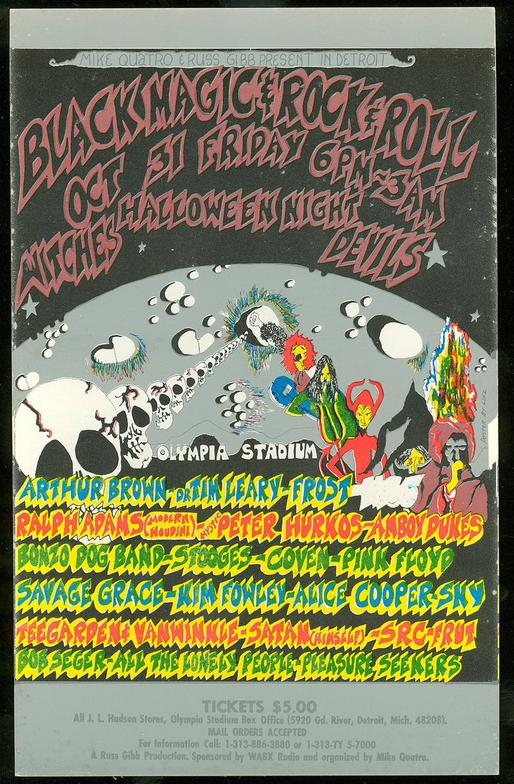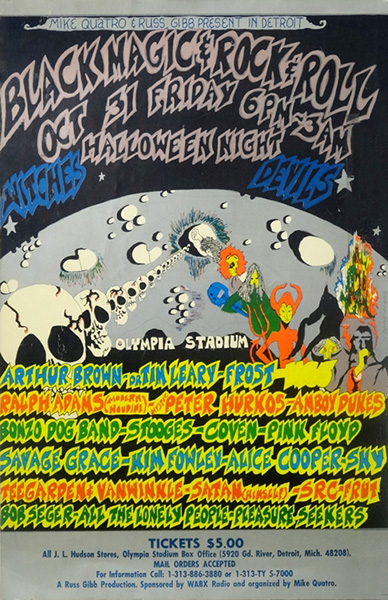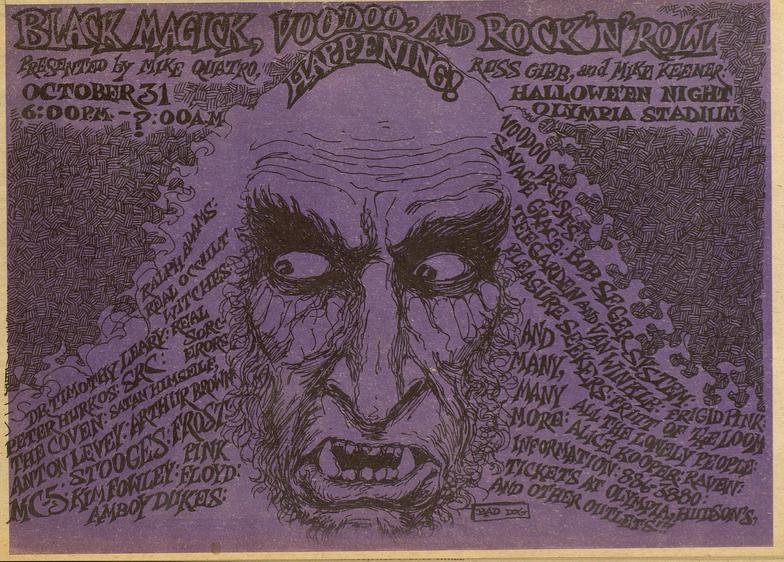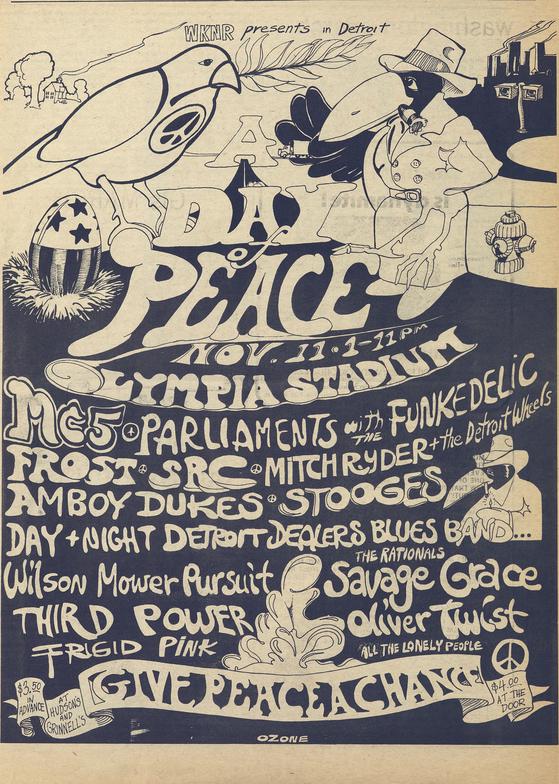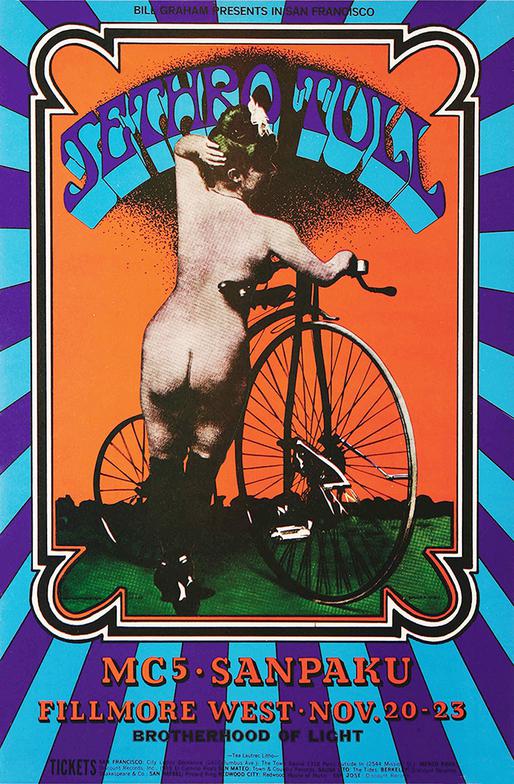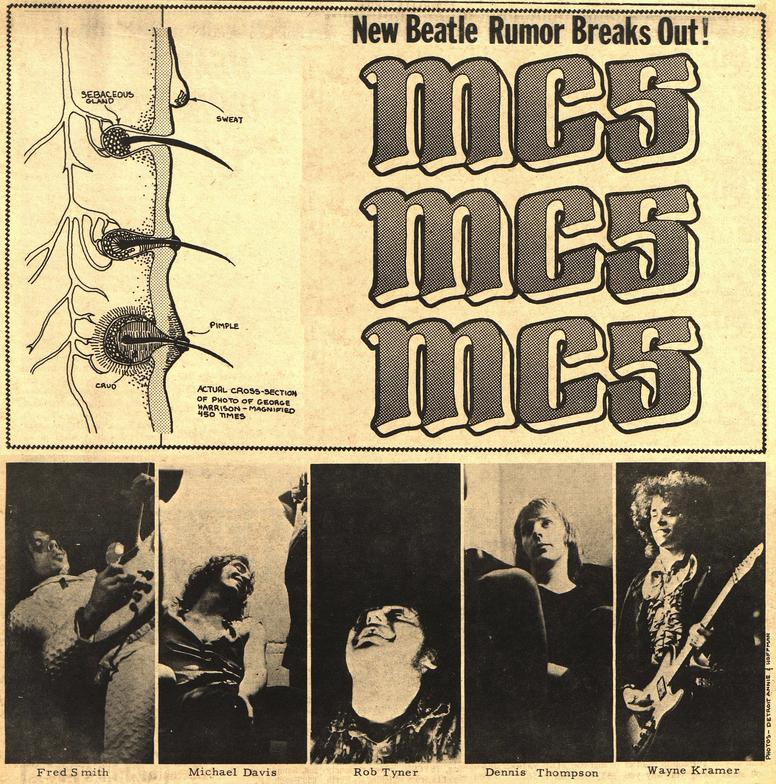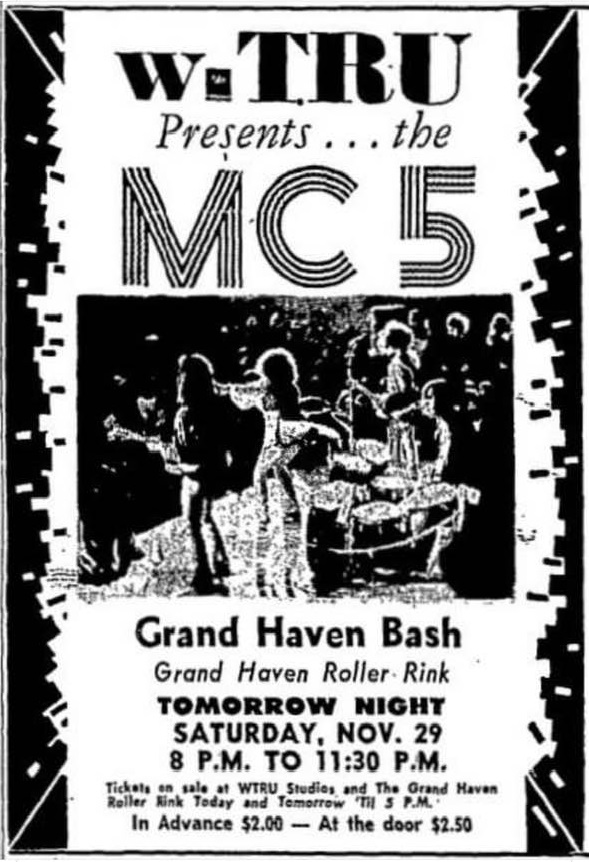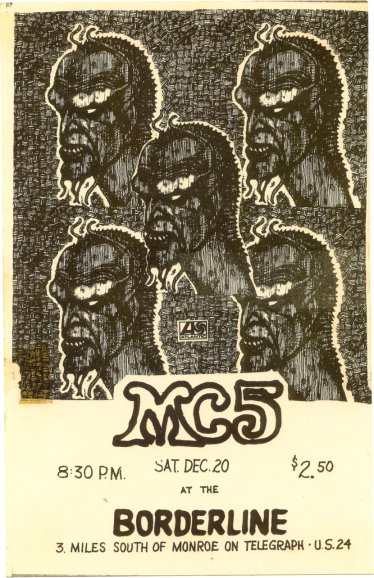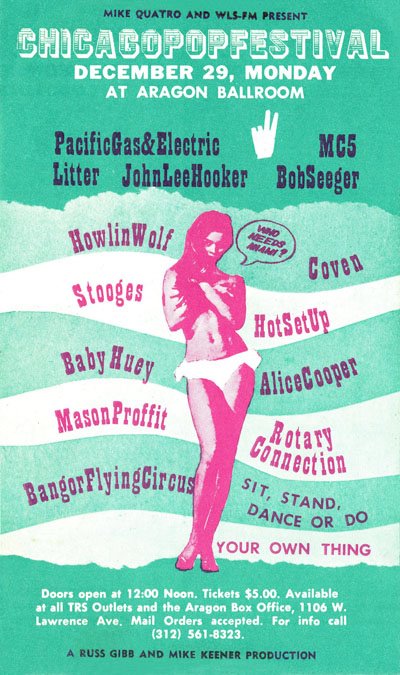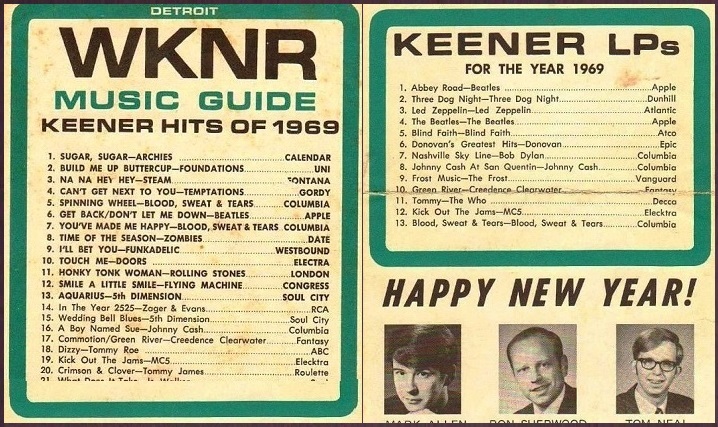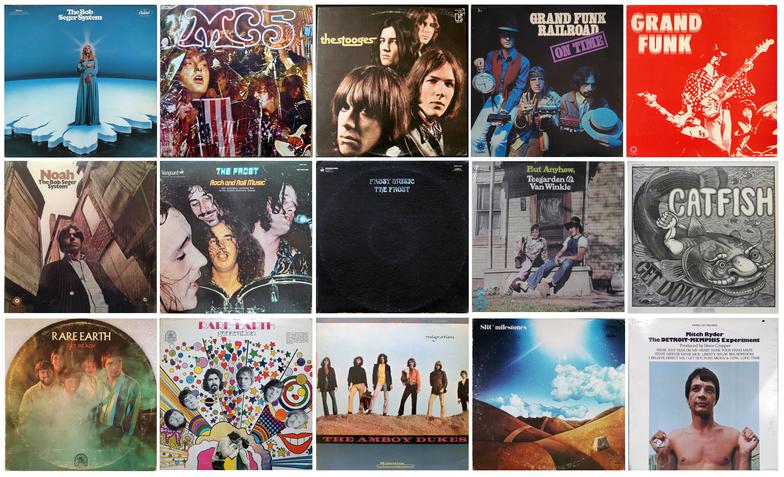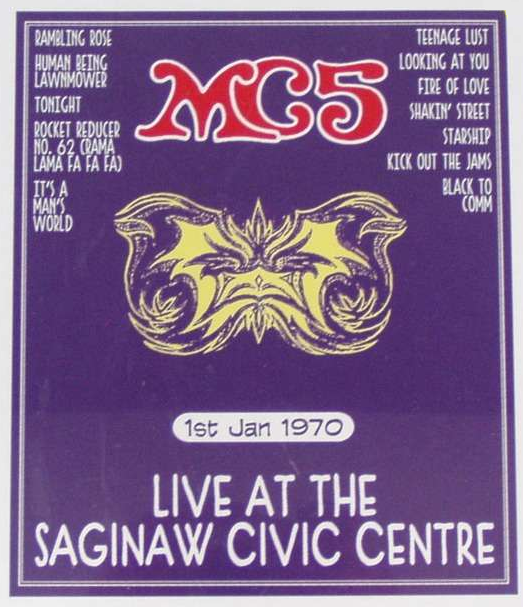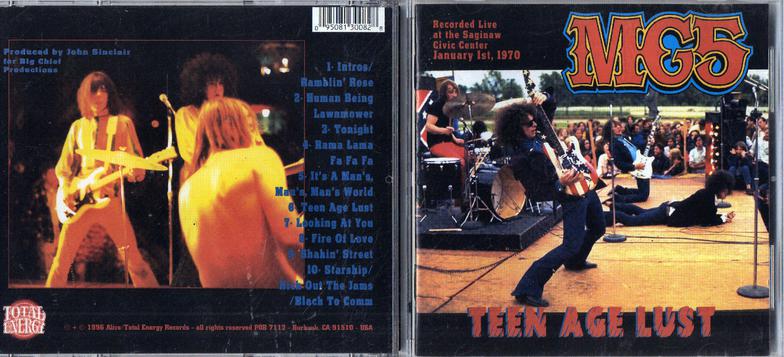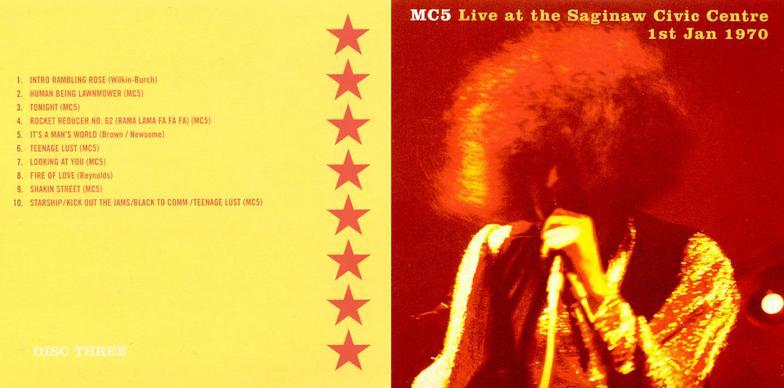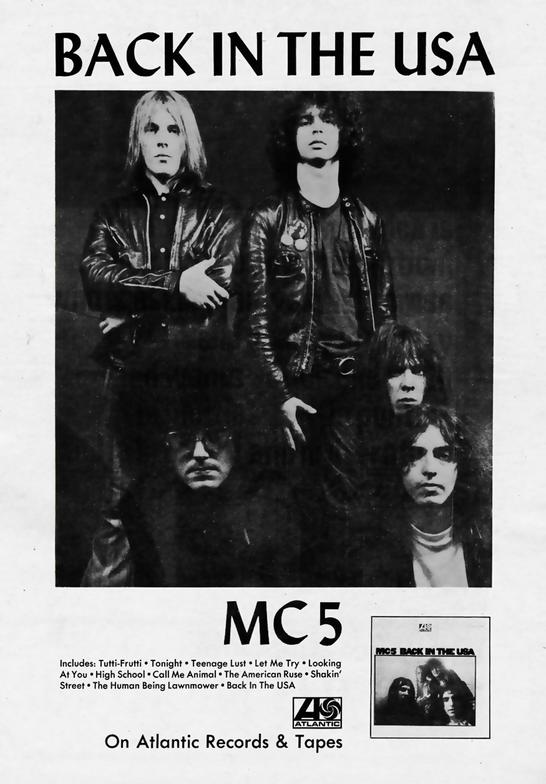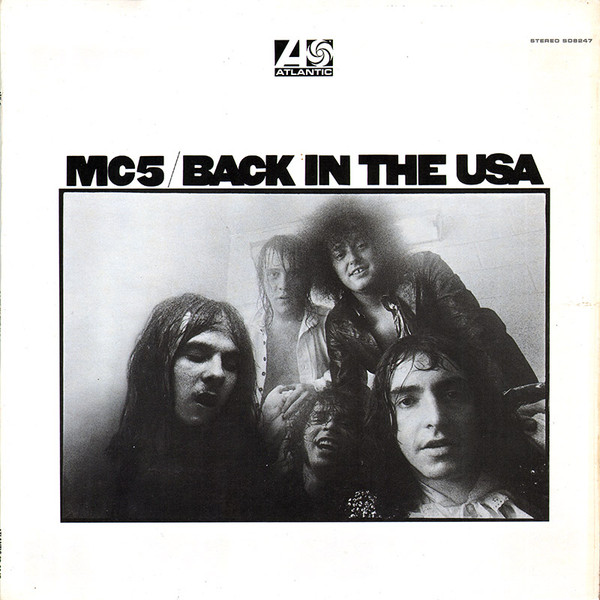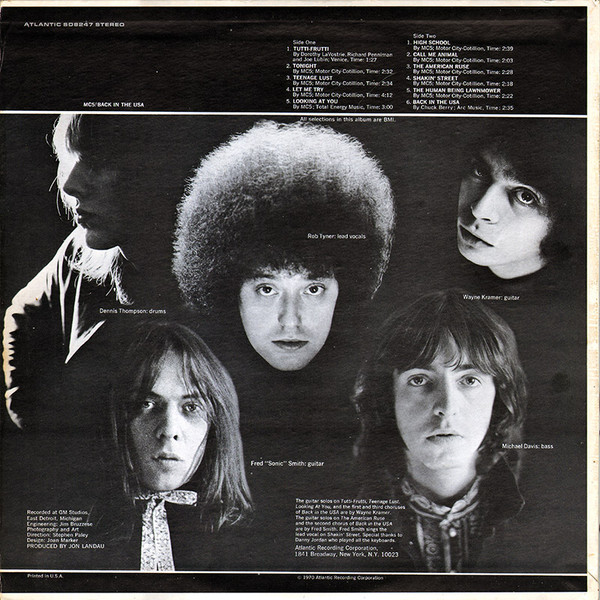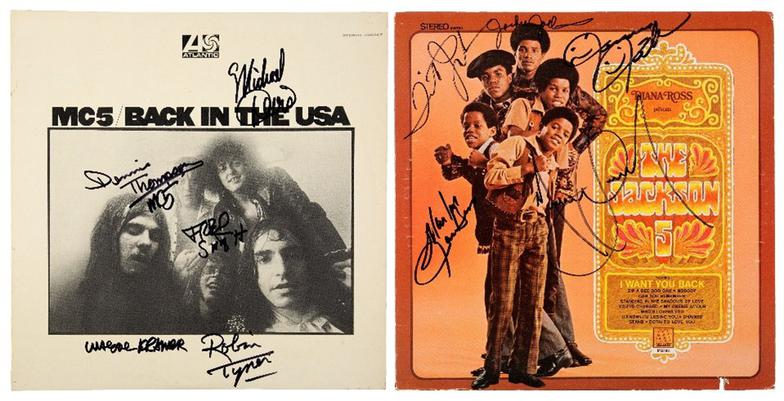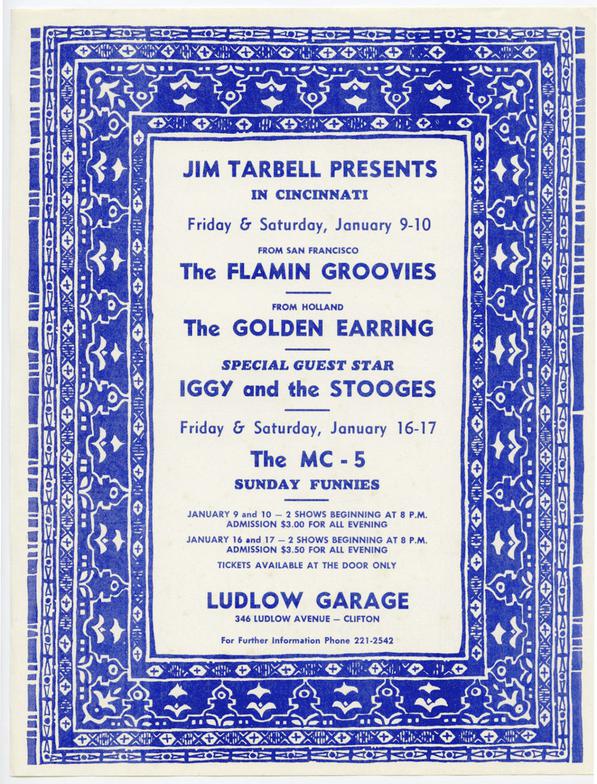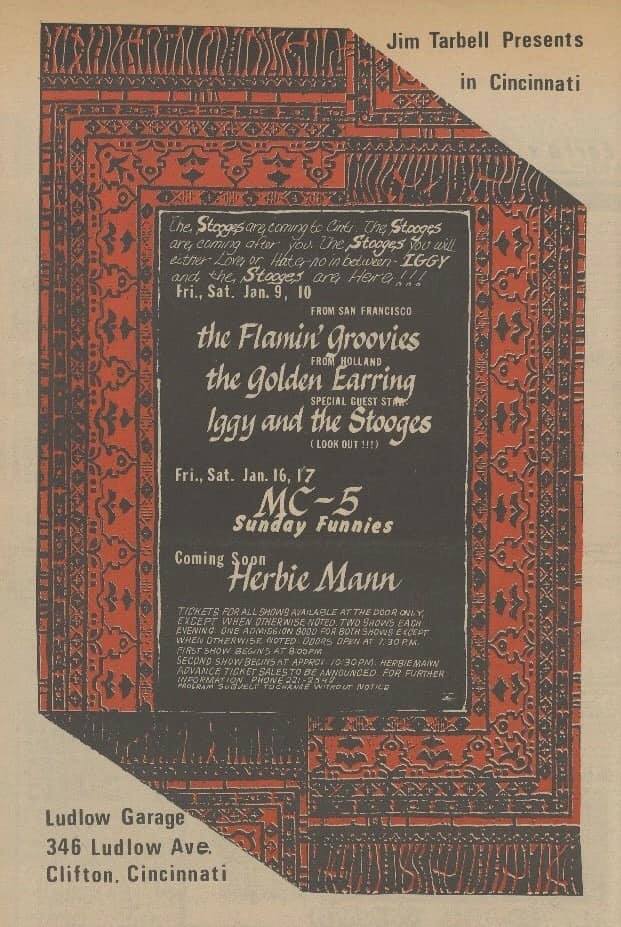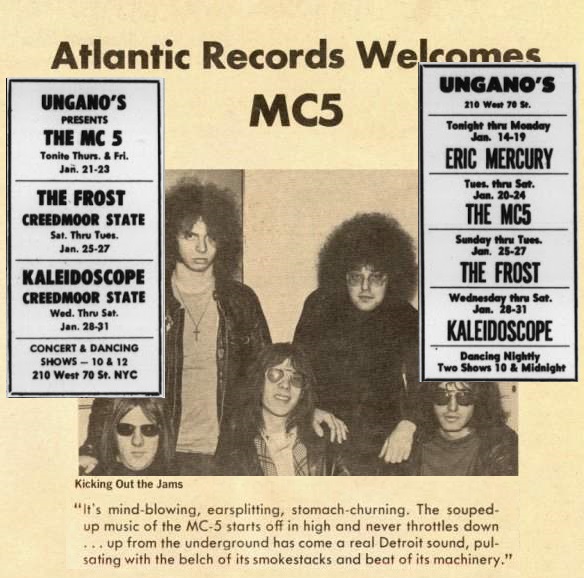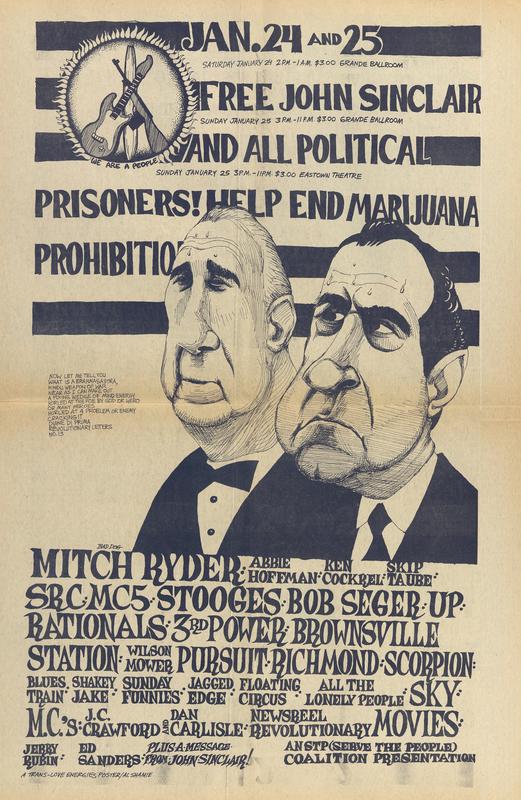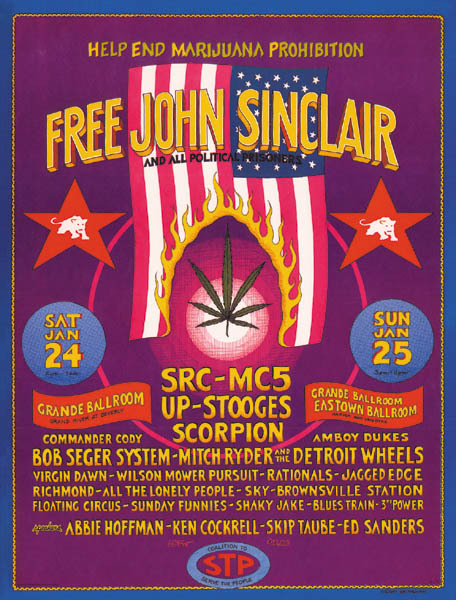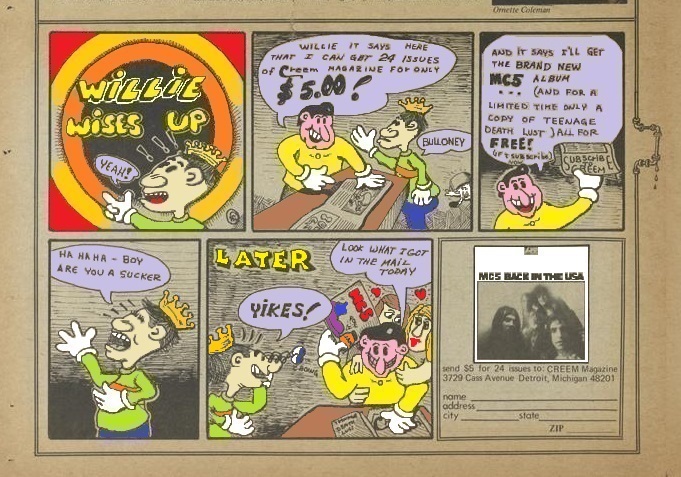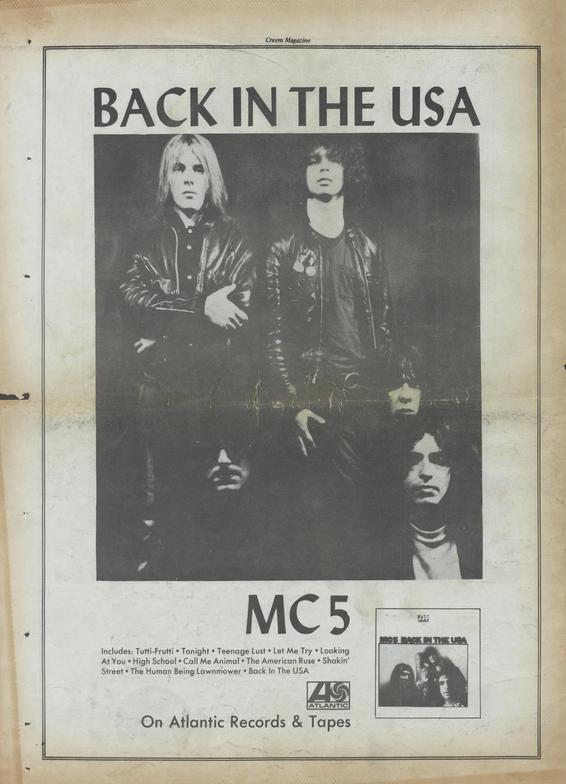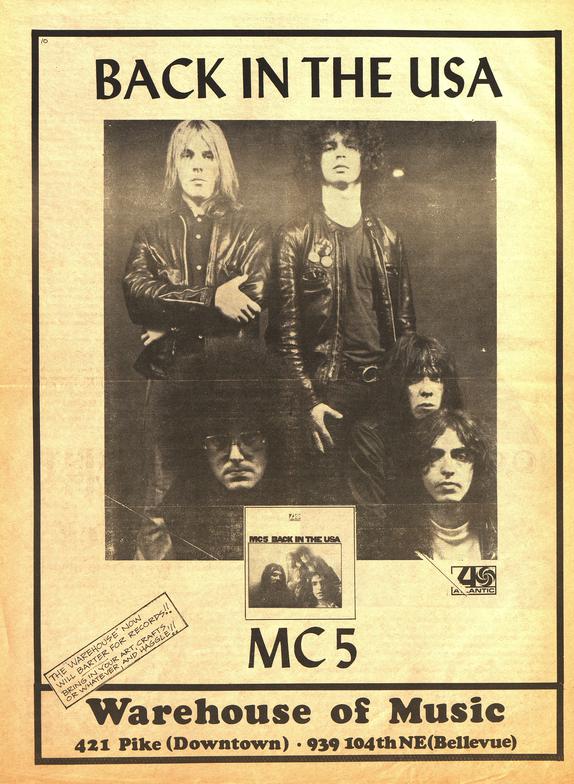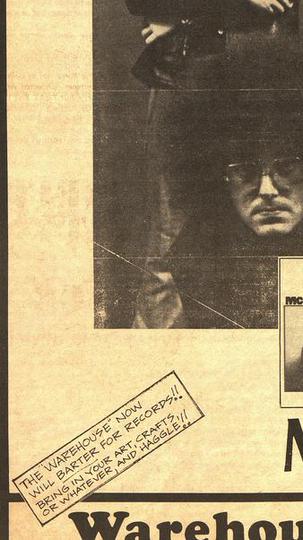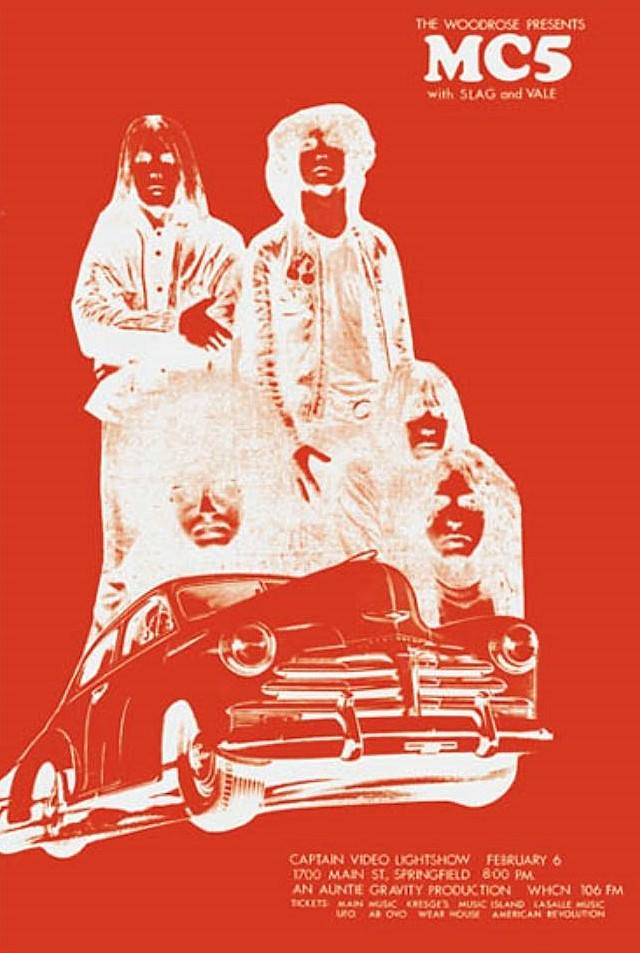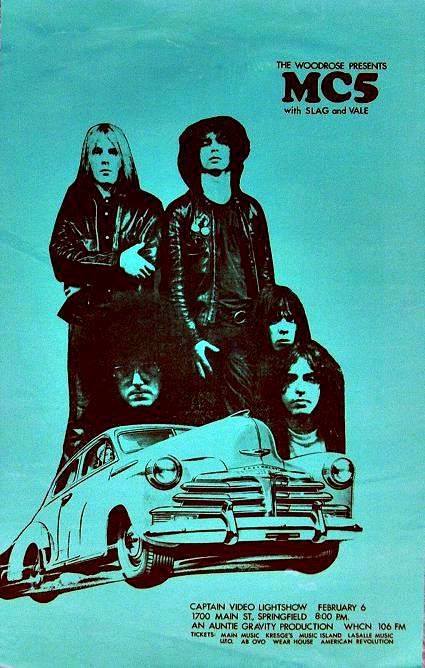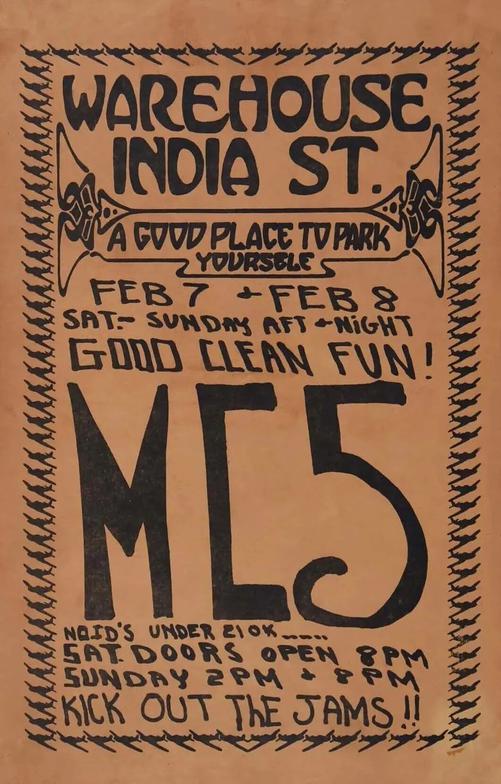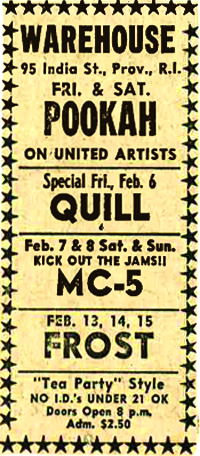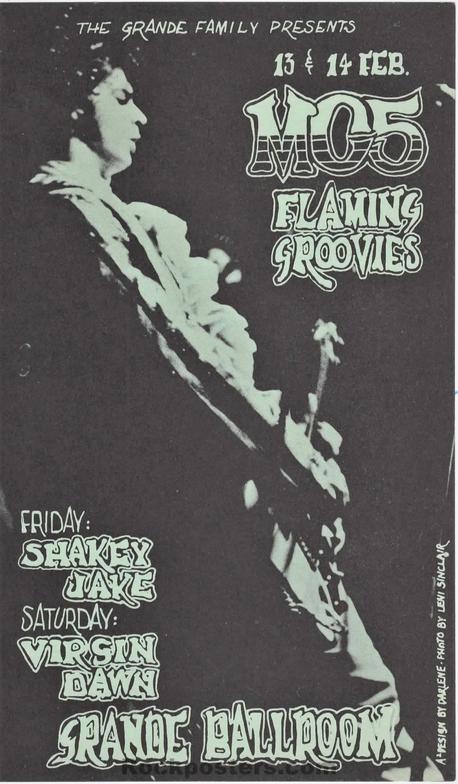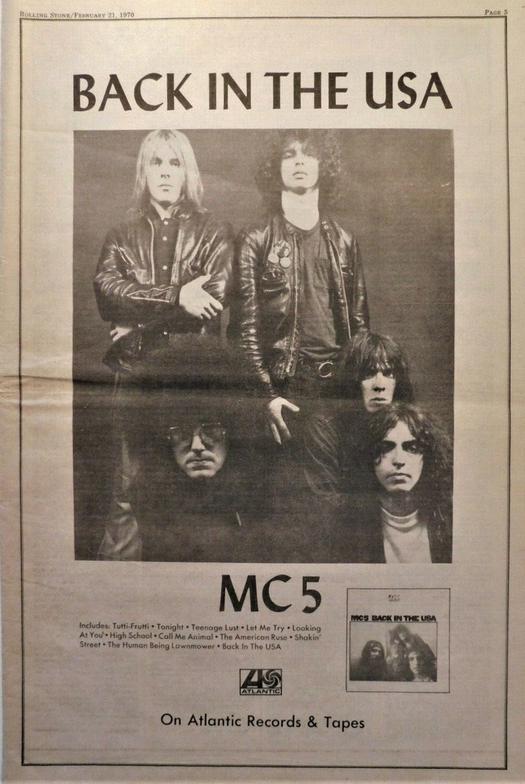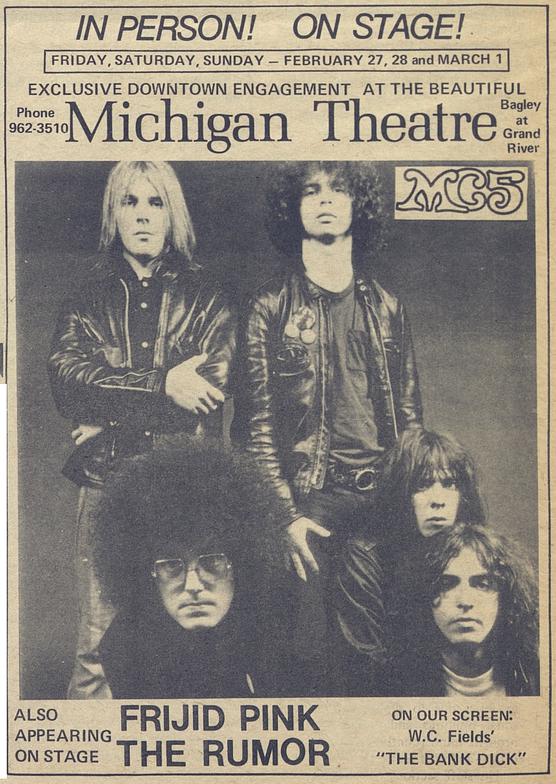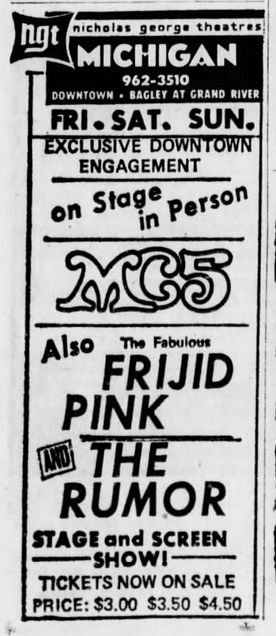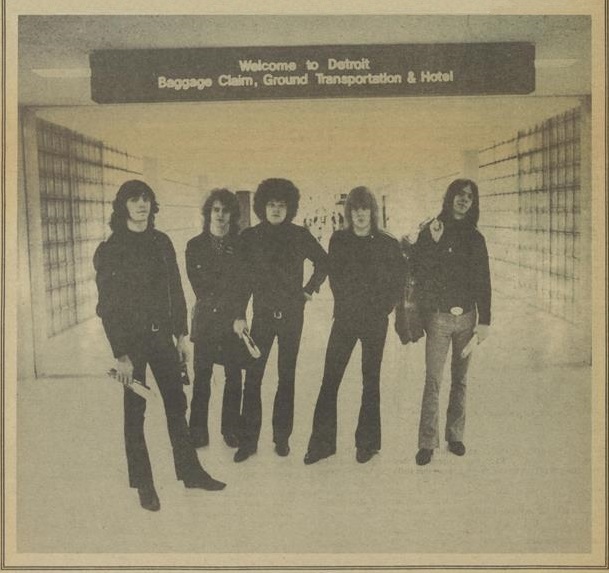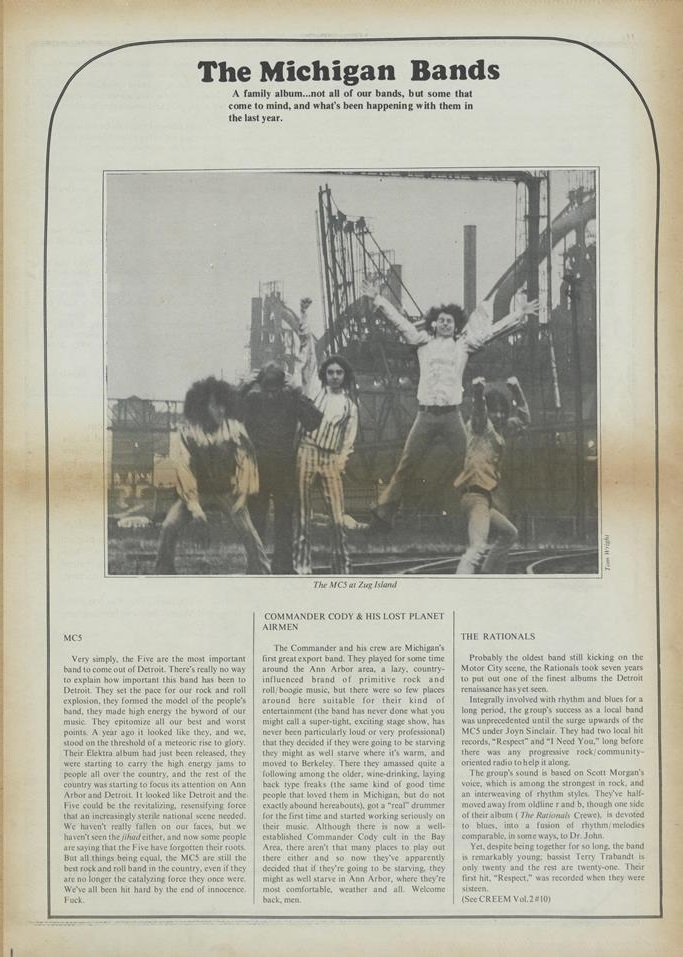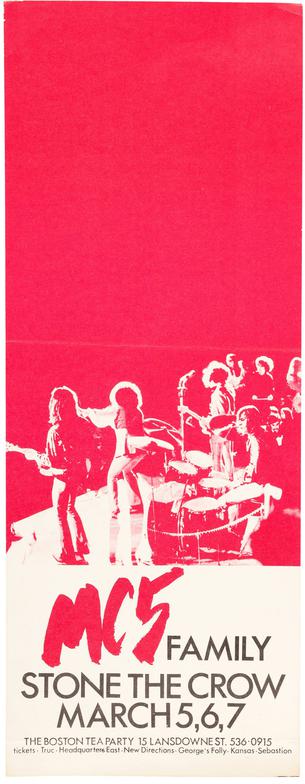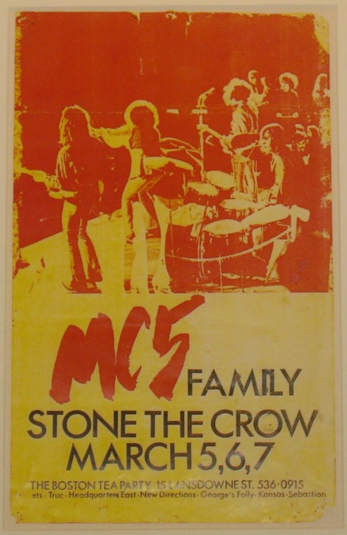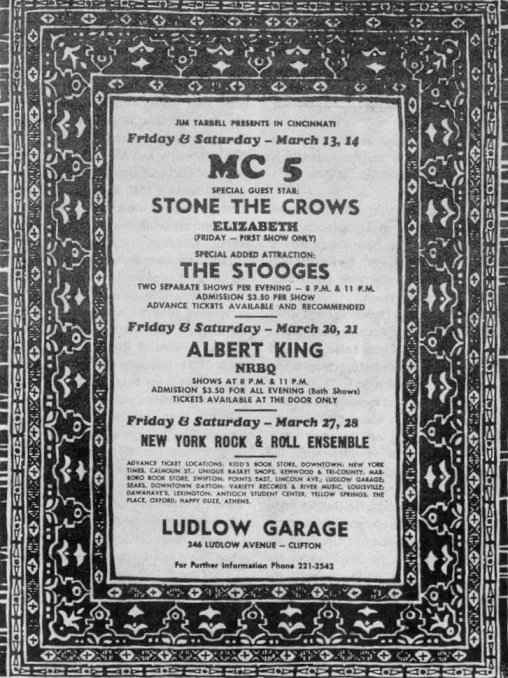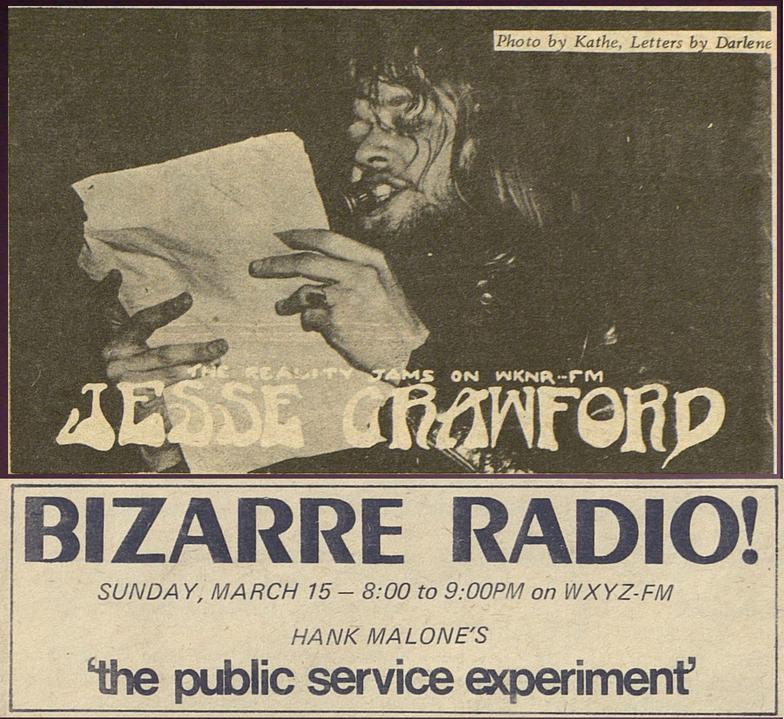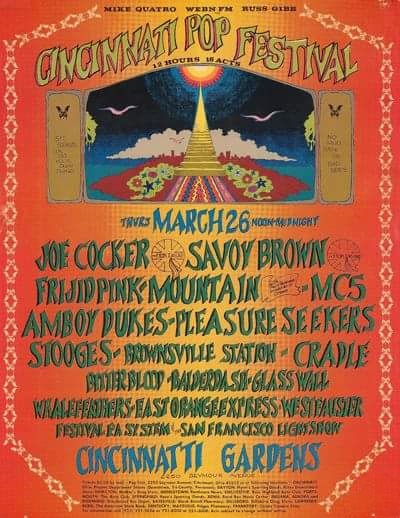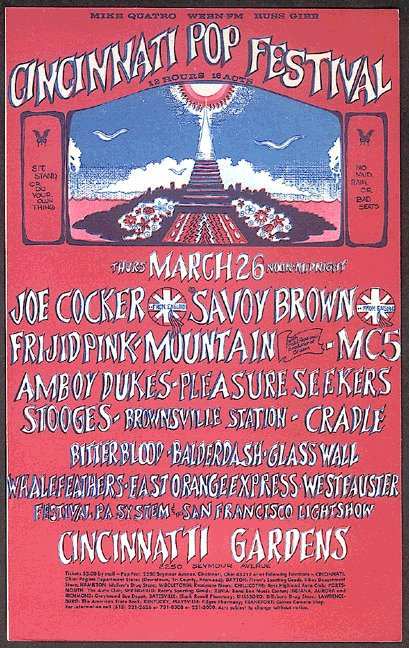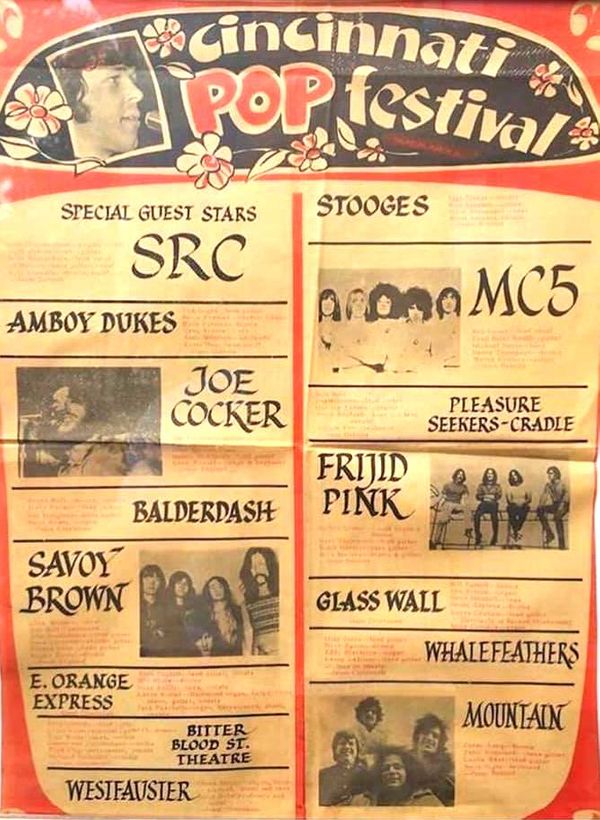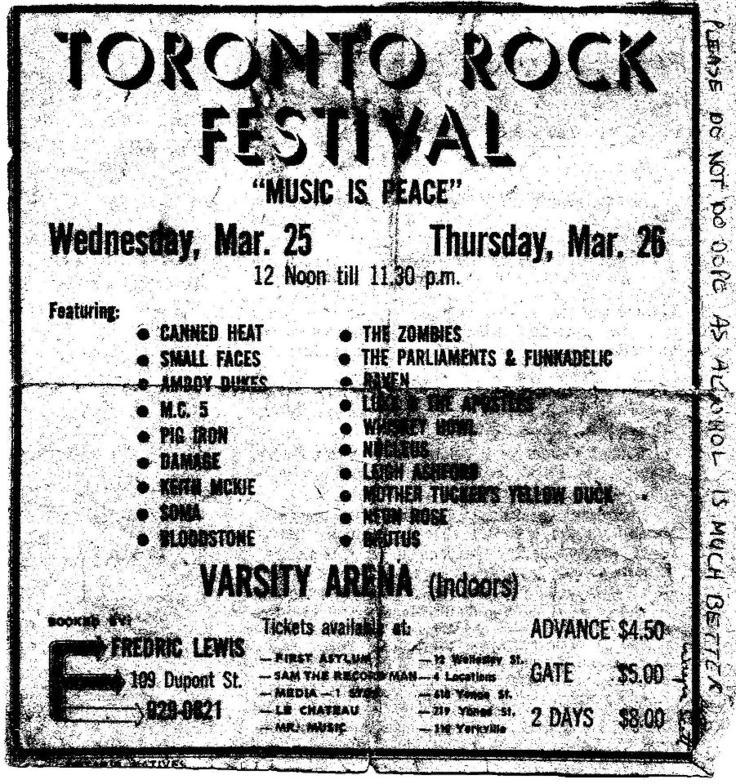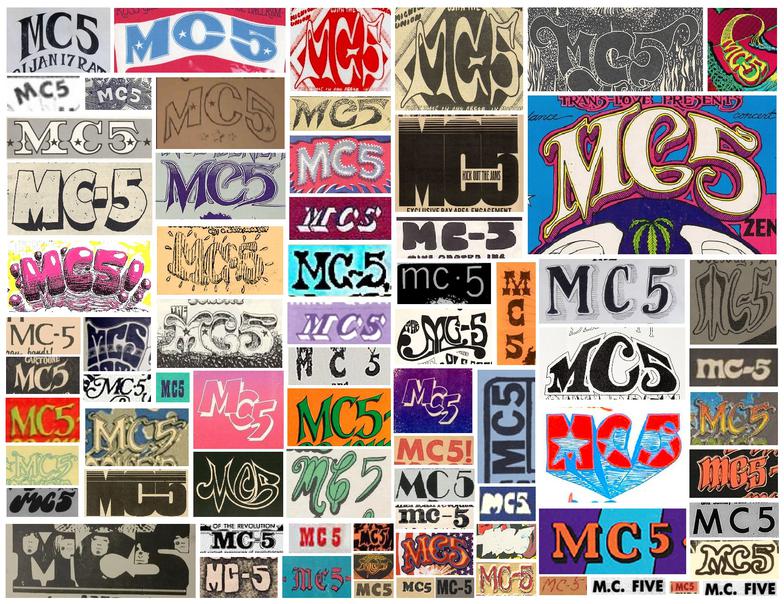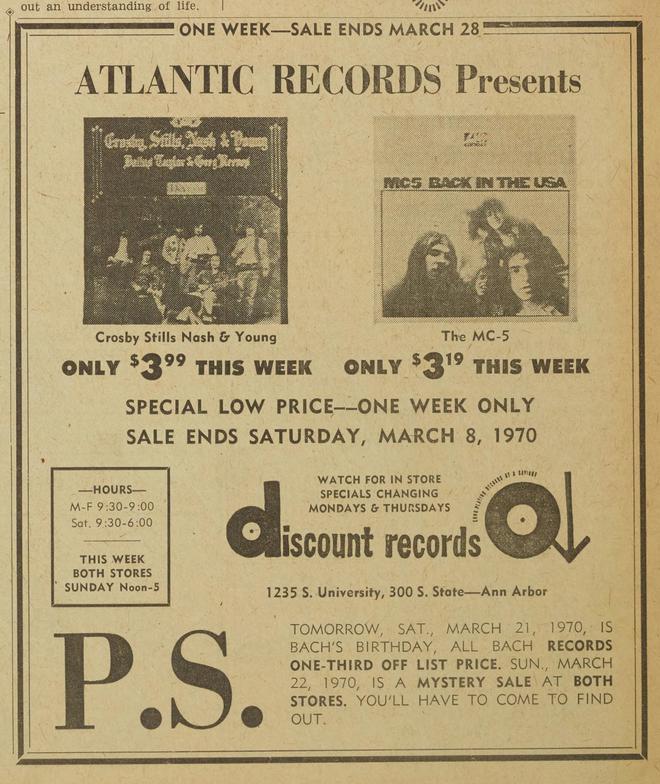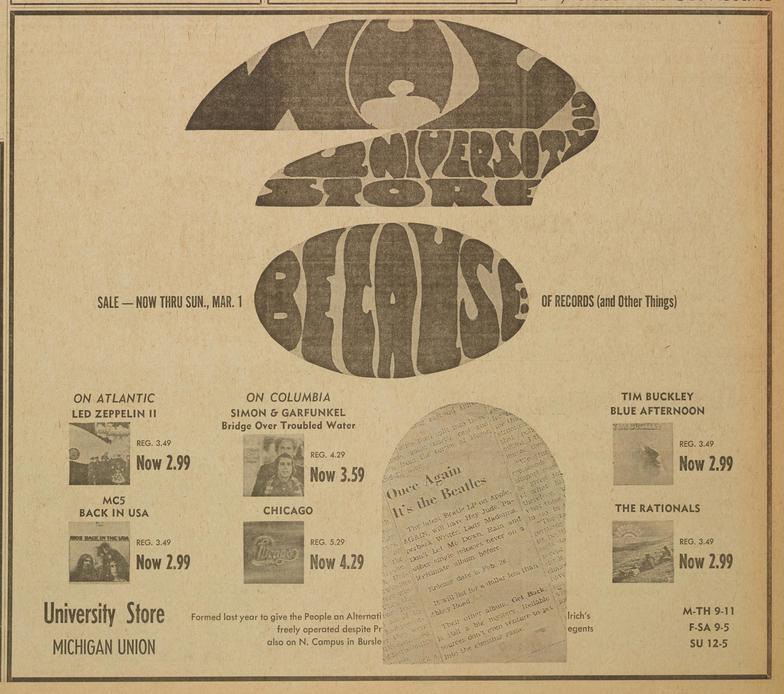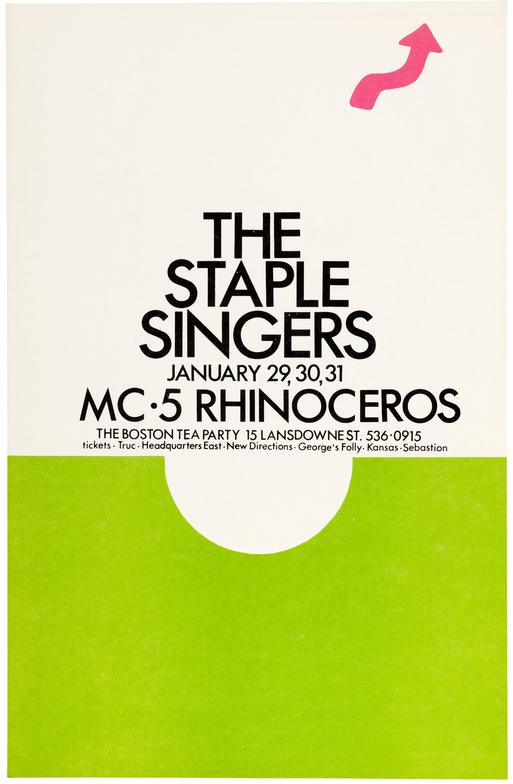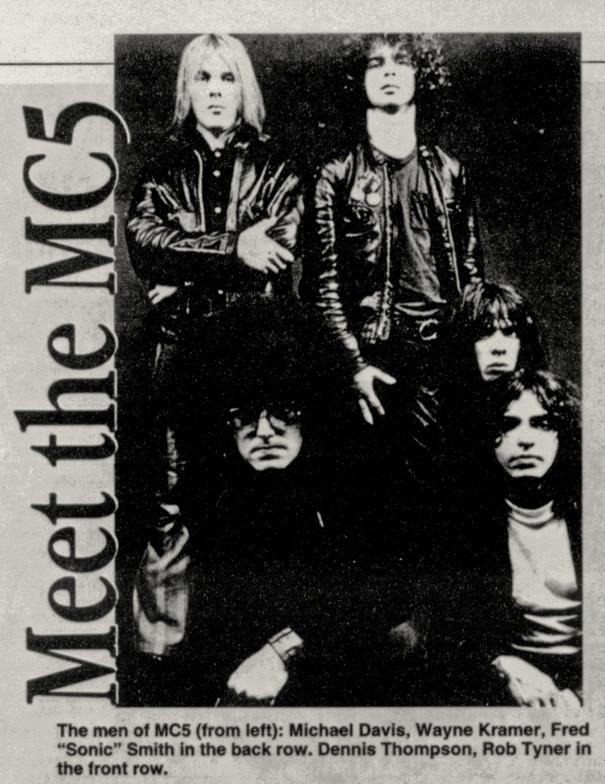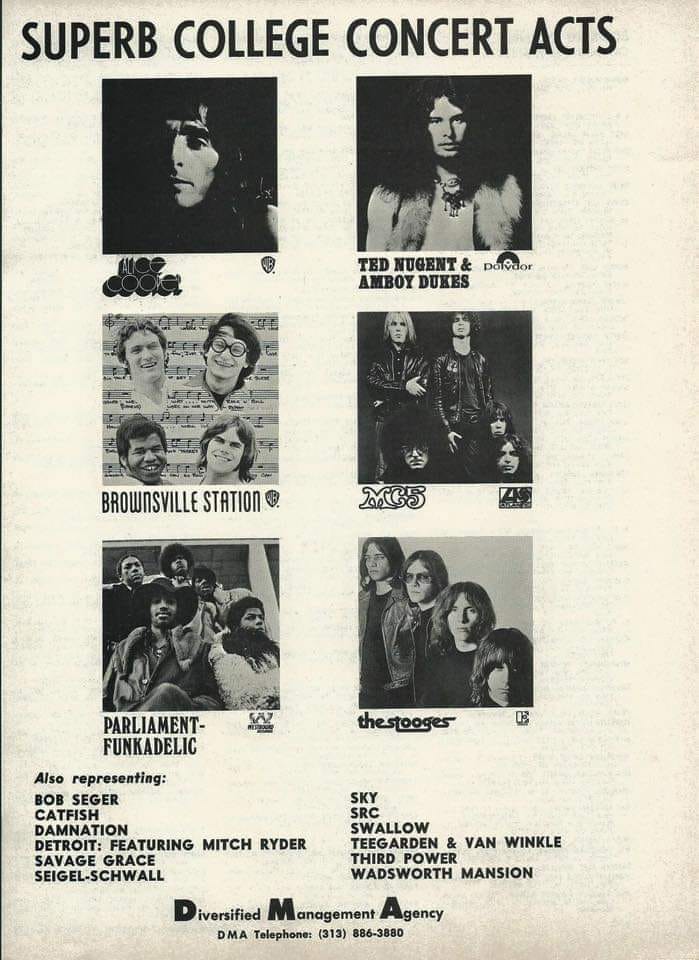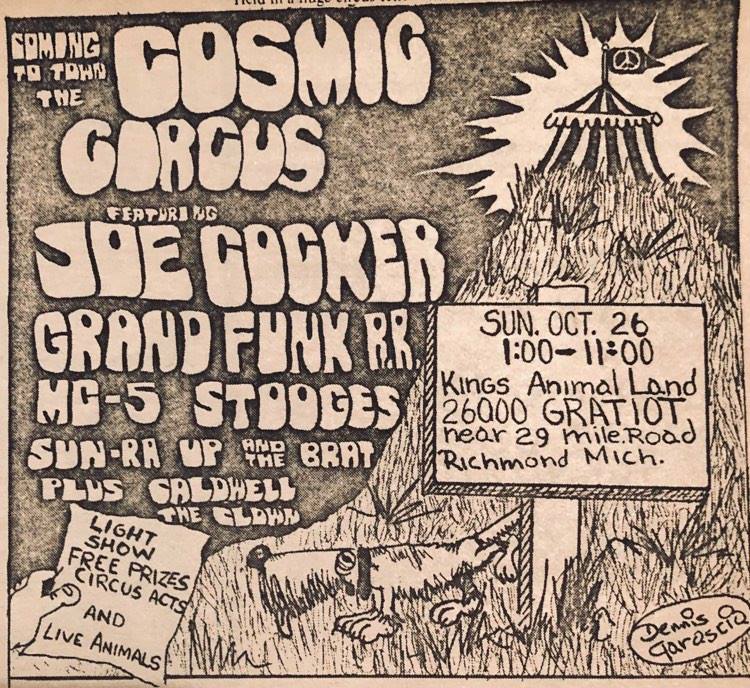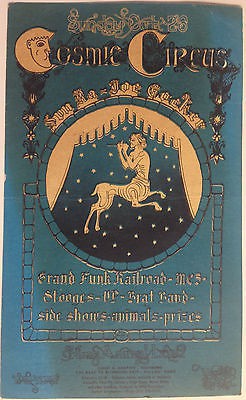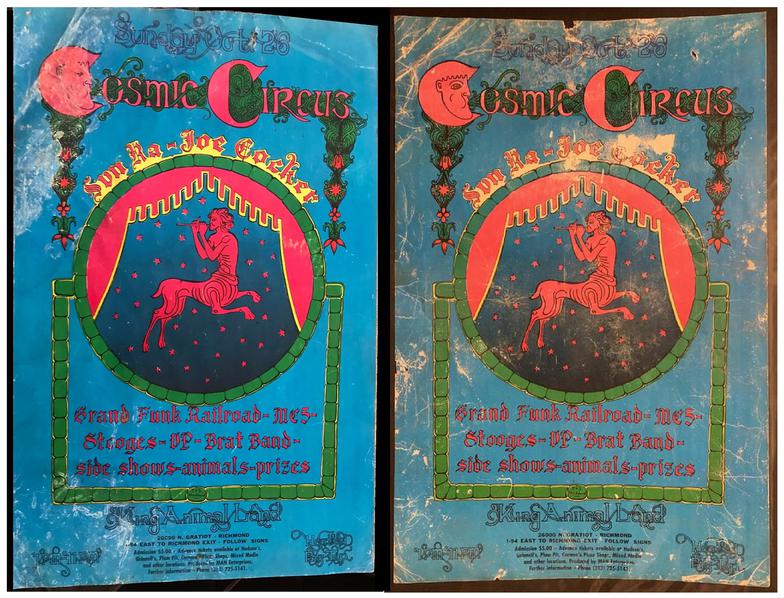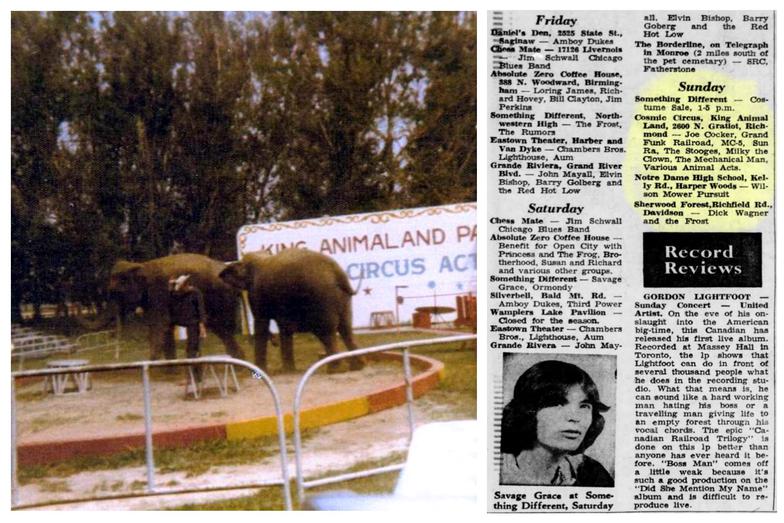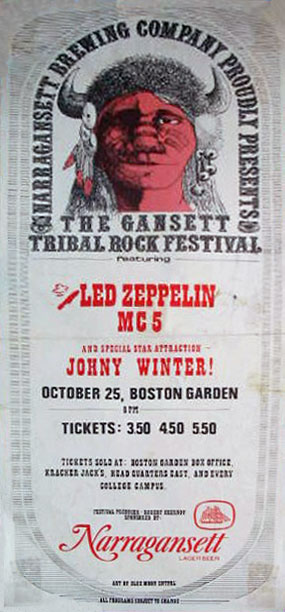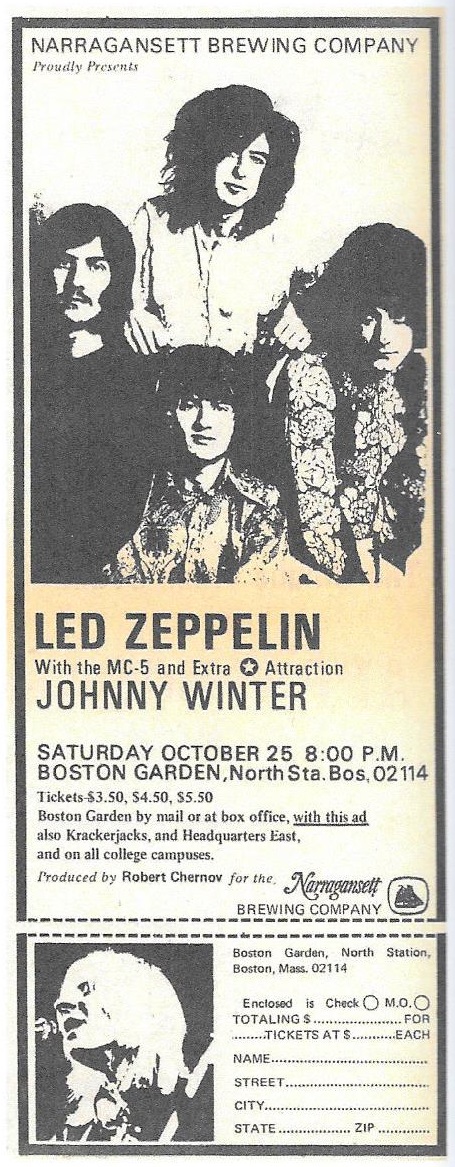Splatt Gallery
Double click here to add text.
Splatt Gallery's History of Michigan Music Posters
MC5 - Page Nine
************************************************************
Color version of the poster by Linz for the ill-fated Black Magic & Rock & Roll festival at Olympia Stadium in Detroit, Halloween night, October 31, 1969. Before this version was printed, the MC5 must have contacted the promoters and had their name blanked out, because they had never actually been asked to play or booked. The same can be said for four other of the acts, Pink Floyd, Arthur Brown, Kim Fowley, and Satan, himself, none of these had ever been approached to play either, promoter Mike Quatro gets the blame, apparently, he just dreamt them up.
Poster by Al Shamie (Bad Dog) for the Black Magic Rock & Roll Show on Halloween night, October 31, 1969 at the Olympia Stadium in Detroit, Michigan. MC5 listed in lower right corner.
An amazing line-up for the Day of Peace, November 11, 1969, which was planned as a follow-up to the Halloween Black Magic show at the Olympia Stadium in Detroit, but with the trouble caused at the end of that show, the Day of Peace was cancelled. Poster by Chris Frayne (Ozone).
Maybe it had been Russ Gibb’s outreach over the summer, or simply the passage of a year’s time, but it seems that Bill Graham had gotten over his grudge against the MC5 and he booked them for four nights at the Fillmore West in San Francisco, opening for Jethro Tull, November 20-23, 1969.
The poster is by Fillmore artist Randy Tuten, whose style, and especially his hand-lettering, is remarkably close to that of Gary Grimshaw’s.
More goodies from the November 27, 1969 issue of The Berkeley Tribe newspaper, with Gary Grimshaw lettering and photos (possibly from the Fillmore shows) by Detroit Annie, who along with writers Sundog (Gary Grimshaw?), and Nixon, was among the Detroit ex-pats working at the paper.
An ad for the MC5 at the Grand Haven Roller Rink in Grand Haven, Michigan on November 29, 1969, a show that is missing from both the database and the gateway, making it another “found” show, or a cancelled gig.
Al Shamie (Bad Dog) used a variation on the theme of his poster from the week before for the Borderline in Monroe, Michigan, for this one with the MC5, December20, 1969.
Wrapping up what had certainly been THE year for pop and rock festivals, the Chicago Pop Festival, December 29, 1969 re-used the same poster that Carl Lundgren had designed for the first Detroit Pop Festival way back in April, and which had already been re-used for the Grand Rapids and Saginaw festivals as well, each one always asking, “Who needs Miami?”
Michigan artists at the Chicago Pop Festival included the MC5, John Lee Hooker, Bob Seger, the Stooges, and Alice Cooper.
An article in The Chicago Seed newspaper called it the “Chicago Poop Festival” and righteously railed against the trend to label every multi-act concert as a festival, particularly in a cramped venue such as the Aragon Ballroom, which he saw as pure capitalist exploitation, and he had especially sharp, and again righteous, criticism for promoter Mike Quatro, making special note that he lived in a $50,000 home (!) in Grosse Pointe.
The writer, named Eliot, was also apparently in the camp of MC5 fans who felt the band lost something when they separated from John Sinclair, he printed Sinclair’s parting quote to the band, “You only wanted to be bigger than The Beatles and all I wanted was for you to be bigger than Mao Tse-Tung.”
AM Radio was still supportive of its local scenes and the Keener-13 year-end Top Twenty for 1969 was probably the only in the country to have Funkadelic, MC5, and Frost on it.
But Detroit was no different than the rest of country when it came to the stranglehold that “bubblegum pop” had on the AM dial, everyone was nauseatingly “Dizzy” from the “Sugar, Sugar” of all the “Buttercup”.
1969 was a break-out year for albums by Michigan rock groups, with debut releases by Bob Seger, MC5, Stooges, Grand Funk Railroad, Frost, and Catfish. Seger, GFR, and Frost also released their second albums within the year.
The Amboy Dukes released their third album (with a corresponding third band line-up), SRC and Teegarden & Van Winkle each released their seconds, Rare Earth released their second and their third, and Mitch Ryder released his second solo album.
1970
Starting with the very first day of the New Year, the very first day of the new decade, the MC5 played a show at the Saginaw Civic Center in Saginaw, Michigan, January 1, 1970. The show was recorded and has been the source of numerous bootlegs. The recording is unique in that it captures a rare cover of “Fire of Love”, by Jody Reynolds on, as Rob Tyner points out, the Demon label.
The MC5 – Fire of Love (live in Saginaw) (01/01/70)
https://www.youtube.com/watch?v=d0iPovg4EmI
The bootleg “Teen Age Lust” at the Saginaw Civic Center in Saginaw, Michigan, January 1, 1970.
On January 15, 1970, Atlantic Records released the second album by The MC5. The complete album can be heard by the link below:
MC5 – Back In The USA (album) (1970)
https://www.youtube.com/watch?v=ctJxt5fbW-Q&list=PLbaroU7wiNr10RVPd8TogKpkSCq4AM0qb
The Motor City’s two “fives”, at the opposite ends of the musical spectrum from each other, but each taking on the world. The MC5’s second album “Back in the USA” was released on January 15, 1970. The Jackson 5 released their debut album on Motown Records just five weeks earlier, on December 12, 1969. And…all ten autographs!
We’ve always thought that the posters for the Ludlow Garage in Cincinnati, Ohio, looked like Persian rugs and now we’ve learned that was deliberate. Promoter Jim Tarbell, who opened The Garage in 1969, offered Persian rugs for sale to concert goers for floor seating in the club, you could have your name put on them and keep them at the club for future shows.
Both The Stooges and The MC5 made the trip to Cincinnati to play at the Ludlow Garage in January, 1970, with The Stooges appearing on the 9th and 10th, and the MC5 with the Sunday Funnies the following weekend, January 16-17, 1970.
A second version of the poster is unique by having the corners of the rug folded over, for a nice touch.
The MC5 went to New York City to promote the new album and were booked at Ungano’s for four nights, January 20-24, 1970, but the band wanted to be back in Detroit to be at the epicenter of a nation-wide “Free John Sinclair Day” on the 24th, so they cut the Ungano’s gig short by a night.
As we mentioned before, Ungano’s was a friendly spot for the Detroit bands, you can see that Frost followed the MC5 with three nights at the tiny NYC club.
One of the coolest poster that came out of the underground press for the nation-wide “Free John Sinclair Day”, January 24-25, 1970, was this one by Al Shamie (Bad Dog) in The Fifth Estate newspaper in Detroit.
The MC5 interrupted their East Coast tour to fly back to Detroit to participate in these shows, with one at the Grande Ballroom and one at the Eastown Theater.
And the best one, of course, was this classic by Gary Grimshaw, his first poster for the Grande Ballroom in eight months. Grimshaw was finally able to use the artwork he had originally planned as the cover to the first MC5 album. In fact, this one is probably closer to the original MC5 cover than the so-called original that was used on the 1991 re-issue of Kick Out The Jams, since one of the objections to the artwork, in addition to the marijuana leaf, was the burning American flag, which the re-issue version does not have.
The event was planned over two days, with a show at the Grande Ballroom on January 24th, and shows at both the Grande and the Eastown on the 25th. The line-up was a stellar collection of the top Michigan groups, plus some relative newcomers. Neither Abbie Hoffman nor Ed Sanders made it to the shows.
The MC5 had cut their four-night stand at Ungano’s in New York City short by a night so that they could fly back to Detroit to take part in the John Sinclair benefit, January 24-25. CREEM Magazine reported that “there was some hostility and bitterness apparent between the audience and the Five due to their split from the Sinclair/Trans-Love organization”, but that they received a standing ovation. The article also mentions that Mitch Ryder and the Detroit Wheels also received a standing ovation at the Sunday show at the Eastown Theater.
The MC5 immediately returned to the East Coast for three nights at the Boston Tea Party, January 29-31, 1970. Poster by the Tea Party’s Bob Driscoll. Strange billing, opening for the gospel soul group, the Staple Singers.
A subscription form from the February 1970 issue of CREEM magazine, illustrated by “FF”, and offering the second album by the MC5 and a copy of “Teenage Death Lust” (also by “FF”) as premiums. It is not too far-fetched to assume that “FF” was staff member Fatmouth Freek.
A full-page Atlantic Records ad for the second album by the MC5 on the back cover of the February 1970 issue of CREEM magazine.
A full-page Warehouse of Music ad in the February 5, 1970 issue of the Helix newspaper in Seattle, Washington for the “Back In The USA” album by the MC5, where you could get the record for three pairs of mittens.
Following the three nights at the Boston Tea Party, the MC5 went to Springfield, Massachusetts for a February 6, 1970 show at The Woodrose Presents, which was run by the original Tea Party manager, Steve Nelson, along with the former Tea Party light show manager John Boyd (Captain Video) and John’s wife Barbara (Auntie Gravity).
Blue version of the poster also shown.
Poster and ad for the MC5 at the Warehouse in Providence, Rhode Island for three shows, February 7-8, 1970, with Frost following them on the 13th through the 15th.
The cooperative agreement between Russ Gibb and Bob Bagaris and Aaron Russo of the Eastown Theater in October, 1969 when Gibb opened the Grande Riviera had led to much confusion, as we’ve seen, among promoters, the bands and the fans. For some reason, when Gibb closed down the Riviera and re-opened the Grande Ballroom, Bagaris felt that the agreement had been broken.
Gibb had gotten the Grande back onto a regular weekly schedule throughout January, 1970, and there seemed to still be a degree of co-operation. For example, when a fire at the Eastown Theatre cut the MC5’s set short on January 9, the band moved over to the Grande for the next night’s show while the Eastown underwent repairs. Nevertheless, at the end of January, Gibb agreed to fully divest himself from the Grande Ballroom and turned the operation over to a group called The Grande Family. Aaron Russo returned to Chicago.
The Grande Family managed to keep the Ballroom running through February, 1970 until it was closed down for the rest of the year. The Grande Family also revived the practice of making posters for the shows (handbills, actually, as they had been for years), with “The Grande Family Presents” in place of the familiar “Russ Gibb Presents”. All of the posters were made by Darlene Pond.
When The MC5 returned to Detroit, after a two-week East Coast tour, they went back to the Grande Ballroom, February 13-14, 1970. The second in the series of poster handbills by Darlene Pond.
A full-page Atlantic Records ad in the February 21, 1970 issue of Rolling Stone magazine for the second album by the MC5 “Back In The USA”.
The Michigan Theater on Bagley Avenue in Detroit was built during the second great wave of movie theater construction in the late 1920’s, one of the largest, if not the largest, and certainly the most opulent. Like the majority of these great theaters, its popularity and attendance had faded by the 1960’s, and in 1967 it was saved from demolition by Nicholas George who made the physical restorations in hopes of an audience restoration. It re-opened with a screening of “The Valley of the Dolls”.
George operated it simply as a movie theater, never attempting to bring to live music back to the stage, as had been a reliable feature from the 1930’s through the 50’s, when top acts from the Big Band era, from Duke Ellington, to Spike Jones held long and frequent residencies.
By 1970, failure was again imminent, and Robin Seymour convinced George to give the music one last chance, as they booked the MC5 for three nights, February 27 – March 1, 1970.
A nearly surreal photo of the MC5 at the Detroit airport by Charles Auringer in the March 1970 issue of CREEM magazine.
A four-page special in the March 1970 issue of CREEM magazine (its one year anniversary) that profiled (18) Michigan bands; MC5, Commander Cody & His Lost Planet Airmen, the Rationals, Amboy Dukes, Brownsville Station, Frijid Pink, Frost, 3rd Power, Grand Funk, Savage Grace, All The Lonely People, Bob Seger System, the UP, Catfish, SRC, Teegarden & Van Winkle, Mitch Ryder & the Detroit Wheels, and the Stooges.
Photo of the MC5 by Tom Wright, taken on Zug Island, an industrial waste heap in the Detroit River.
Following their re-christening of the Michigan Theatre in Detroit, the MC5 went back to the Boston Tea Party for three nights, March 5-7, 1970.
March 13-14, 1970, found the MC5 back at the Ludlow Garage in Cincinnati, Ohio with another Persian-rug style poster by Jim Tarbell. The Stooges were the openers, with two shows nightly, at 8:00 and 11:00. On this Friday the 13th, the second single from the MC5 album was released on Atlantic Records.
MC5 – Shakin’ Street (1970)
https://www.youtube.com/watch?v=cbVdrnRm4R4
J.C. Crawford, no longer opening the MC5 shows with his Zenta preacher tent-show revival exhortations, landed a radio show on WKNR-FM. Photo by Kathe, letters by Darlene in the March 17, 1970 issue of the Ann Arbor Argus newspaper.
The Cincinnati Pop Festival, March 26, 1970, the third Pop Festival of the month for both the Amboy Dukes and the Stooges. Other Michigan bands at this one included Frijid Pink, Brownsville Station, MC5, and listed under both names, the Pleasure Seekers/Cradle.
It was another Russ Gibb & Mike Quatro production, the poster uses the central image from Gary Grimshaw’s classic Detroit Rock & Roll Revival poster from the year before, and although the lettering emulates Grimshaw, it is much too ragged to have come from his hand.
Note: This is not the 1970 Cincinnati Pop Festival that will occur in June at Crosley Field and is better known because it was partially televised.
Early version poster for the Cincinnati Pop Festival, March 26, 1970, with SRC listed, who seem to have cancelled. The photo at the top of the poster looks like promoter Mike Quatro.
The day before they performed at the Cincinnati Pop Festival, the MC5 performed at the Toronto Rock Festival in Canada, March 25, 1970, (odd that both of these all-day shows were on week-days during the school-year, maybe it was spring break?).
Detroit bands, Amboy Dukes, Parliaments and Funkadelic, also on the two-day bill, on the side of which someone inscribed, “Please do not do dope as alcohol is much better”.
MC5 Poster History - continues - HERE
1969 was the peak year for shows by the MC5 with nearly (150). It was their widest ranging appearances to date with two short West Coast tours, amounting to about (10) shows, and more frequent trips to the East Coast, for about (20) shows.
A Discount Records ad in the March 20, 1970, issue of the Michigan Daily newspaper in Ann Arbor, featuring the second album by the MC5.
An ad in the February 26, 1970 issue of the Michigan Daily newspaper for the University Store in the Michigan Union in Ann Arbor, featuring the second album by the MC5.
Publicity ads for the MC5 at the time of the release of their second album, January 15, 1970.
A sweet illustrated ad by Dennis Garascia for the Cosmic Circus show at King’s Animal Land Park, a petting zoo in Richmond, Michigan, October 26, 1969.
The 19th festival of the year was held at King’s Animal Land Park, a petting zoo in Richmond, Michigan, October 26, 1969, called the Cosmic Circus. One of the stranger venues, headliners were Joe Cocker and Sun Ra, and other featured performers included The Mechanical Man and Milky the Clown, “side shows, animals and prizes”. Michigan bands included Grand Funk Railroad, MC5, Stooges, UP and Brat.
Here are two copies of the color version, artist is J+S Stoddard.
Newspaper listing for the Cosmic Circus at King’s Animal Land Park, a petting zoo in Richmond, Michigan, October 26, 1969.
The MC5 made a quick Saturday night trip to Boston to open for Johnny Winter and Led Zeppelin at the "Narragansett's First Tribal Rock Festival" on October 25, 1969. The use of the word “festival” beginning to lose meaning.


